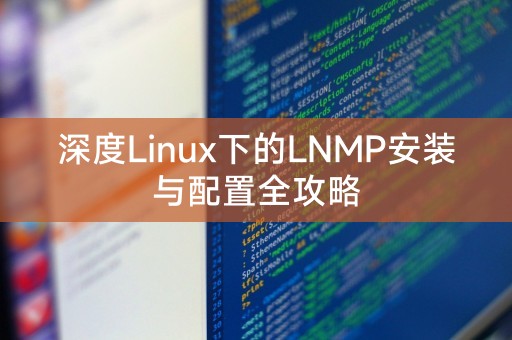
php editor Xinyi has brought an in-depth guide on LNMP installation and configuration under Linux to help users quickly build a high-performance web server environment. This guide details the concepts and advantages of LNMP, as well as the steps and precautions required to install and configure LNMP on a Linux system. Whether you are a beginner or an experienced user, you can easily build a stable and secure LNMP environment through this guide to provide better services for your website or application.

Before starting the installation, please make sure that your Deepin Linux system has been updated to the latest version and has administrator rights.
1. Open the terminal and use the following command to install Nginx:
```shell
sudo apt-get install nginx
```
2. After the installation is complete, use the following command to start the Nginx service:
sudo systemctl start nginx
3. You can use the following command to check the Nginx service Is it running normally:
sudo systemctl status nginx
1. Use the following command in the terminal to install MySQL:
sudo apt-get install mysql-server mysql-client
2. During the installation process, you will be prompted to set the MySQL root user password, so be sure to remember it.
3. After the installation is complete, use the following command to start the MySQL service:
sudo systemctl start mysql
1. Use the following in the terminal Command to install PHP and its related extensions:
sudo apt-get install php php-mysql php-fpm php-xml php-zip php-curl php-gd
2. After the installation is complete, Restart the Nginx service to make PHP take effect:
sudo systemctl restart nginx
1. Configure Nginx to support PHP: Open the Nginx configuration file `/etc/ nginx/sites-available/default`, find the following content and uncomment it:
```ruby
location ~ \.php$ {
include snippets/fastcgi- php.conf;
fastcgi_pass unix:/var/run/php/php7.0-fpm.sock;
fastcgi_param SCRIPT_FILENAME $document_root$fastcgi_script_name;
}
```2. Restart the Nginx service to make the configuration take effect: `sudo systemctl restart nginx`. The LNMP environment has been installed and configured on Deepin Linux. You can verify the environment by creating a test file containing PHP code. If it works properly, save the following code as `info.php` file and place it in the web root directory of Nginx (default is `/var/www/html/`): Then visit it in the browser, If the PHP information can be displayed normally, it means that the LNMP environment has been set up successfully. Let me share with you: A little LINUX knowledge. File and directory permissions in Linux are an important part of Linux system security. Each file and directory has corresponding permission settings. , including read, write and execution permissions. By properly setting the permissions of files and directories, you can ensure that different users can only access and operate the files and directories they need, thereby improving the security of the system. You can use the `chmod` command to Modify the permissions of files and directories. To set the file to be readable, writable and executable by all users, you can use the following command: `chmod 777 filename`, `7` means read, write and execute permissions, `filename` is the Modify the file name of the permissions. I hope this little knowledge can help you better understand and use the file and directory permissions of the Linux system.
The above is the detailed content of Complete guide to LNMP installation and configuration under Deepin Linux. For more information, please follow other related articles on the PHP Chinese website!




